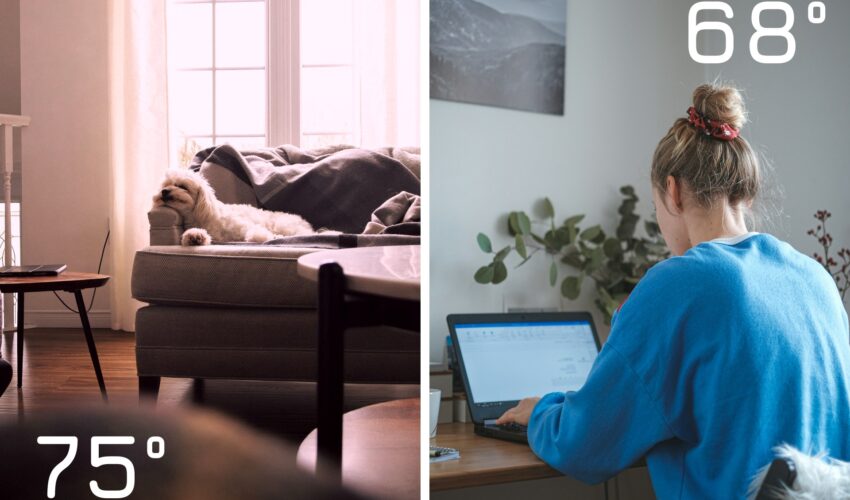Does your upstairs feel like a sauna while the downstairs is freezing? Or does your home office turn into an icebox when you try to cool the rest of the house? If so, you might be a great candidate for HVAC zoning.
Zoning is one of the most effective ways to improve comfort, efficiency, and control in your home. Below we discuss how zoning works, what the system is made up of, common concerns, and when it’s worth the investment.
What Is HVAC Zoning?
HVAC zoning divides your home into separate climate zones so you can control the temperature in each area independently. Instead of relying on a single thermostat to heat or cool the entire house evenly–which almost never works out–zoning lets you direct airflow only where it’s needed. This reduces energy waste and increases comfort room by room.
What Are the Main Parts of a Zoned HVAC System?
- Thermostats
Each zone has its own thermostat that can sense the temperature in the area and communicates with a central control panel, giving you full control over setting the temperature in that zone. - Sensors
To ensure proper temperature readings, sensors can be placed in other areas of your home. Unlike thermostats, sensors won’t allow you to set a separate temperature, but they will send signals to the control panel allowing airflow to be modified based on the reading to maintain the temperature set by the thermostat associated with that zone. - Control Panel
The panel receives signals from each zone and tells the dampers what to do based on the input. - Automatic Dampers
These powered components look like an empty soup can with a flat metal plate inside. This metal piece rotates to open and close within the ductwork to route air where it’s needed. Unlike manual dampers, which are not made to be adjusted seasonally–generally only during installation–and aren’t suitable for everyday use or zoning control, automatic dampers respond in real-time to thermostat settings.
What Alternatives Exist?
Mini-splits are an alternative option to an automated zoning system. With a mini-split, each area would need its own unit with a remote control. These are great for renovations, additions, or homes without ductwork. Because mini-splits are essentially a stand-alone system, they tend to be more expensive, harder to troubleshoot, and less reliable long-term than central zoning.
Who Should Consider Zoning?
Zoning is perfect for homes or buildings with multiple floors–especially if the upstairs gets too hot or too cold, rooms with large windows or lots of sunlight, and home offices, gyms, or media rooms used at different times than the rest of the house. People who prefer different temperatures (like multi-generational households, roommates, etc.) or households with closed-door habits can also use zoning to avoid hot or cold spots.
Concerns to Keep in Mind
Zoning systems can be incredible, but only if they’re done right. Here are a few things to consider:
Static Pressure
When air is redirected or blocked, pressure can build up in your ducts. If the excess airflow isn’t dealt with, it can lead to mold problems, equipment failure, noisy operation, and poor system performance.
Cost
Zoning costs generally depend on how much control you want: the more zones you have, the more you’re likely to spend. It often requires new thermostats and wiring, a control panel, automatic dampers, and, at times, even updated HVAC equipment. But for many homeowners, the results are well worth it. A properly designed system brings lasting comfort, energy savings, and peace of mind.
Performance
When zoning, variable-speed HVAC equipment significantly outperforms single-stage equipment, both in performance and efficiency. A generation ago, it was standard to use single-stage equipment with a bypass damper on a zoned system; with today’s technology, there’s no need to do that.
Bad Installations Are Hard to Fix
We can’t stress enough to get your zoning done by a qualified professional. There’s a lot of misinformation online, and cutting corners will cost you later. Poorly designed systems often need to be ripped out and completely redone–including the ducting and AC & heating equipment.
The Bottom Line: Everyone Who Has Zoning Loves It
In our experience, homeowners with properly designed zoned systems rarely look back. Why? Because it solves one of the biggest concerns in home comfort: proper temperature control.
If you’re tired of fighting with the thermostat, or if certain rooms in your home are always uncomfortable, zoning might be the answer. At North East Air Conditioning, Heating & Plumbing, our experienced technicians can walk you through your options and design a system that fits your home and budget.


